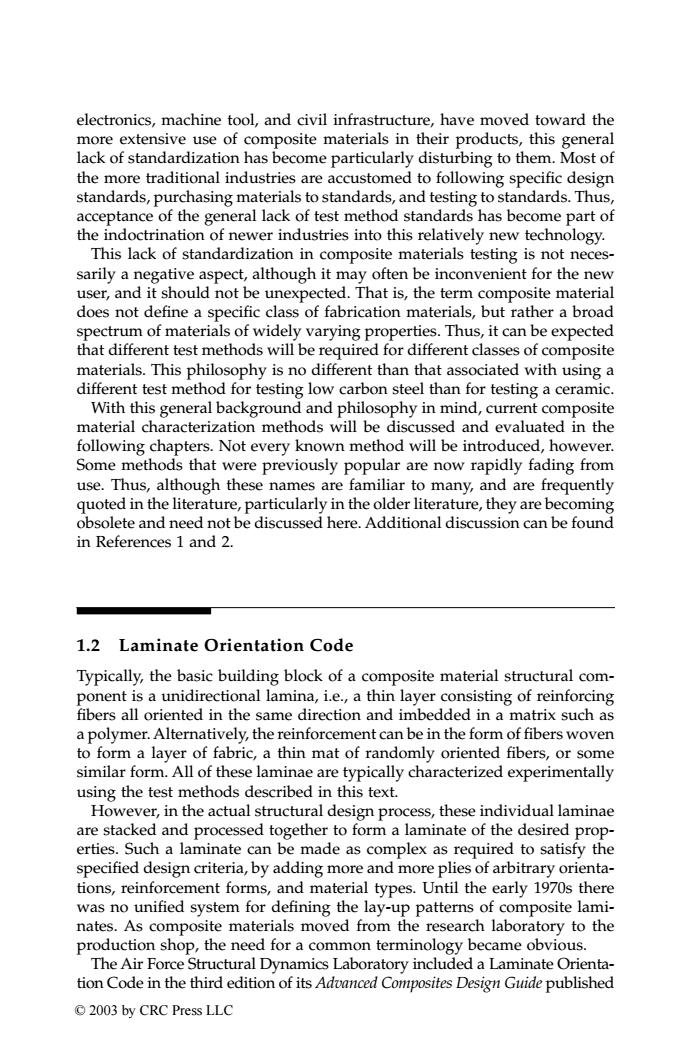正在加载图片...

electronics,machine tool,and civil infrastructure,have moved toward the more extensive use of composite materials in their products,this general lack of standardization has become particularly disturbing to them.Most of the more traditional industries are accustomed to following specific design standards,purchasing materials to standards,and testing to standards.Thus, acceptance of the general lack of test method standards has become part of the indoctrination of newer industries into this relatively new technology. This lack of standardization in composite materials testing is not neces- sarily a negative aspect,although it may often be inconvenient for the new user,and it should not be unexpected.That is,the term composite material does not define a specific class of fabrication materials,but rather a broad spectrum of materials of widely varying properties.Thus,it can be expected that different test methods will be required for different classes of composite materials.This philosophy is no different than that associated with using a different test method for testing low carbon steel than for testing a ceramic. With this general background and philosophy in mind,current composite material characterization methods will be discussed and evaluated in the following chapters.Not every known method will be introduced,however. Some methods that were previously popular are now rapidly fading from use.Thus,although these names are familiar to many,and are frequently quoted in the literature,particularly in the older literature,they are becoming obsolete and need not be discussed here.Additional discussion can be found in References 1 and 2. 1.2 Laminate Orientation Code Typically,the basic building block of a composite material structural com- ponent is a unidirectional lamina,i.e.,a thin layer consisting of reinforcing fibers all oriented in the same direction and imbedded in a matrix such as a polymer.Alternatively,the reinforcement can be in the form of fibers woven to form a layer of fabric,a thin mat of randomly oriented fibers,or some similar form.All of these laminae are typically characterized experimentally using the test methods described in this text. However,in the actual structural design process,these individual laminae are stacked and processed together to form a laminate of the desired prop- erties.Such a laminate can be made as complex as required to satisfy the specified design criteria,by adding more and more plies of arbitrary orienta- tions,reinforcement forms,and material types.Until the early 1970s there was no unified system for defining the lay-up patterns of composite lami- nates.As composite materials moved from the research laboratory to the production shop,the need for a common terminology became obvious. The Air Force Structural Dynamics Laboratory included a Laminate Orienta- tion Code in the third edition of its Advanced Composites Design Guide published ©2003 by CRC Press LLCelectronics, machine tool, and civil infrastructure, have moved toward the more extensive use of composite materials in their products, this general lack of standardization has become particularly disturbing to them. Most of the more traditional industries are accustomed to following specific design standards, purchasing materials to standards, and testing to standards. Thus, acceptance of the general lack of test method standards has become part of the indoctrination of newer industries into this relatively new technology. This lack of standardization in composite materials testing is not necessarily a negative aspect, although it may often be inconvenient for the new user, and it should not be unexpected. That is, the term composite material does not define a specific class of fabrication materials, but rather a broad spectrum of materials of widely varying properties. Thus, it can be expected that different test methods will be required for different classes of composite materials. This philosophy is no different than that associated with using a different test method for testing low carbon steel than for testing a ceramic. With this general background and philosophy in mind, current composite material characterization methods will be discussed and evaluated in the following chapters. Not every known method will be introduced, however. Some methods that were previously popular are now rapidly fading from use. Thus, although these names are familiar to many, and are frequently quoted in the literature, particularly in the older literature, they are becoming obsolete and need not be discussed here. Additional discussion can be found in References 1 and 2. 1.2 Laminate Orientation Code Typically, the basic building block of a composite material structural component is a unidirectional lamina, i.e., a thin layer consisting of reinforcing fibers all oriented in the same direction and imbedded in a matrix such as a polymer. Alternatively, the reinforcement can be in the form of fibers woven to form a layer of fabric, a thin mat of randomly oriented fibers, or some similar form. All of these laminae are typically characterized experimentally using the test methods described in this text. However, in the actual structural design process, these individual laminae are stacked and processed together to form a laminate of the desired properties. Such a laminate can be made as complex as required to satisfy the specified design criteria, by adding more and more plies of arbitrary orientations, reinforcement forms, and material types. Until the early 1970s there was no unified system for defining the lay-up patterns of composite laminates. As composite materials moved from the research laboratory to the production shop, the need for a common terminology became obvious. The Air Force Structural Dynamics Laboratory included a Laminate Orientation Code in the third edition of its Advanced Composites Design Guide published TX001_ch01_Frame Page 3 Saturday, September 21, 2002 4:47 AM © 2003 by CRC Press LLC